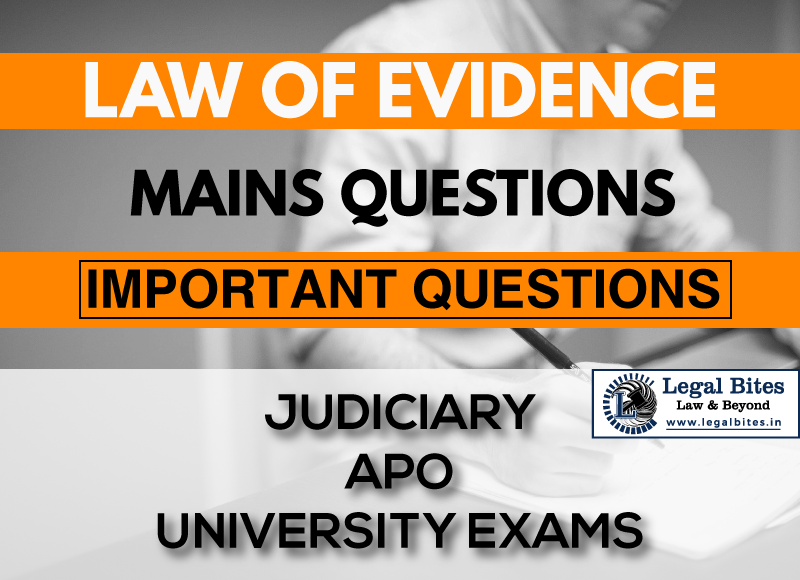Are the remarks of the spectators made at the time when A beat B in their presence relevant? Answer in relation to the Indian Evidence Act?
Question: Are the remarks of the spectators made at the time when A beat B in their presence relevant? Answer in relation to the Indian Evidence Act? [U.P.A.P.O. 1996] Find the answer to the mains question only on Legal Bites. [Are the remarks of the spectators made at the time when A beat B in their presence relevant?]… Read More »
;
Question: Are the remarks of the spectators made at the time when A beat B in their presence relevant? Answer in relation to the Indian Evidence Act? [U.P.A.P.O. 1996] Find the answer to the mains question only on Legal Bites. [Are the remarks of the spectators made at the time when A beat B in their presence relevant?] Answer Section 6 of the Indian Evidence Act provides Facts so connected with a fact in issue as to form part of the same transaction. This section receives evidence of all...
Question: Are the remarks of the spectators made at the time when A beat B in their presence relevant? Answer in relation to the Indian Evidence Act? [U.P.A.P.O. 1996]
Find the answer to the mains question only on Legal Bites. [Are the remarks of the spectators made at the time when A beat B in their presence relevant?]
Answer
Section 6 of the Indian Evidence Act provides Facts so connected with a fact in issue as to form part of the same transaction. This section receives evidence of all acts and statements connected with a happening in such-wise as to form an integral part of the happening. It is based upon the doctrine of res gestae.
This section admits those facts the admissibility of which comes under the technical expression res gestae [i.e. the things done (including words spoken) in the course of a transaction], but such facts must “form part of the same transaction”.
If facts form part of the transaction which is the subject of inquiry, manifestly evidence of them ought not to be excluded. Every fact which is part of the same transaction as the fact in issue is deemed to be relevant to the fact in issue although it may not be actually in issue, and although if it were not part of the same transaction it might be excluded as hearsay.
Illustration (a) to the section clarifies this- A is accused of the murder of B by beating him. Whatever was said or done by A or B or the by-standers at the beating, or so shortly before or after it as to form part of the transaction, is a relevant fact.
Thus, a transaction consists both of the physical acts and the words accompanying such physical acts, whether spoken by the person doing such acts, the person to whom they were done or any other person or persons. Such words are admissible in evidence as parts of a transaction. The expression “bystanders” used in illustration (a) means the persons who are present at the time of the occurrence and not those who gather on the spot after the occurrence.
The statement as that in Illustration (a) is relevant only if it is that of a person who has seen the actual occurrence and who uttered it simultaneously with the incident or so soon thereafter as to make it reasonably certain that the speaker is still under the stress of the excitement caused by his having seen the incident.
As the court in case of Shayam Nandan Singh v. State of Bihar, 1991 Cr LJ 3359 the court has observed where an FIR lodged soon after the incident by persons who witnessed it becomes a part of the happening and hence, the statement uttered or act done must be a spontaneous reaction of the person witnessing the crime and forming part of the transaction.
Therefore, as part of the doctrine of res gestae under section 6 of the IEA, it can be said that remarks of the spectators made at the time when A beat B in their presence, forms the part of the same transaction and hence is relevant.
Important Mains Questions Series for Judiciary, APO & University Exams
- Law of Evidence Mains Questions Series Part-I
- Law of Evidence Mains Questions Series Part-II
- Law of Evidence Mains Questions Series Part-III
- Law of Evidence Mains Questions Series Part-IV
- Law of Evidence Mains Questions Series Part-V
- Law of Evidence Mains Questions Series Part-VI
- Law of Evidence Mains Questions Series Part-VII
- Law of Evidence Mains Questions Series Part-VIII
- Law of Evidence Mains Questions Series Part-IX
- Law of Evidence Mains Questions Series Part-X

